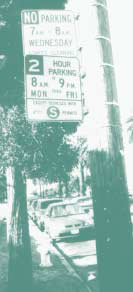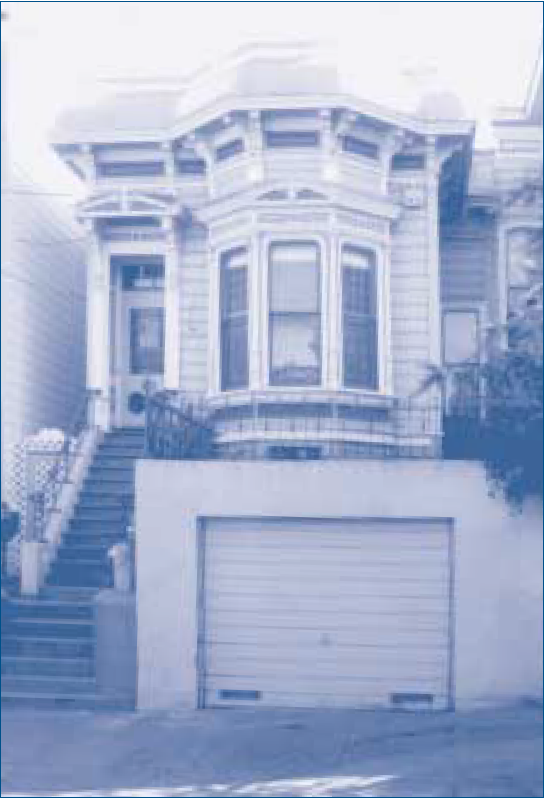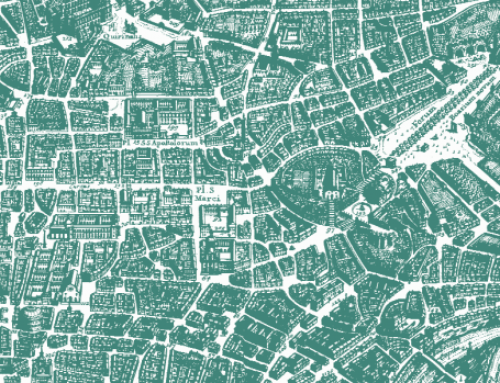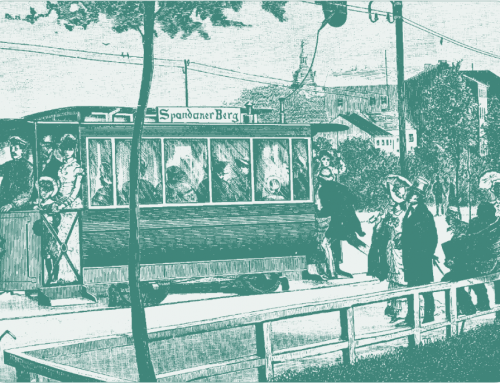[sharelines]Parking makes housing more expensive.
 Housing affordability and parking availability are two of the most vexing problems in the nation’s largest cities. In San Francisco, internationally known for its ambience, most working people find it almost impossible to find a house, condo, or apartment at an affordable price. Finding a parking space is nearly as difficult. Many houses are situated on very narrow lots, and frequent curb cuts for driveways reduce on-street parking. Cars circle the block looking for rare empty spaces. Residents say parking problems are a major bane of urban life. In many other urban centers as well—including New York, Chicago, Boston, and Seattle—housing costs and parking availability are twin public-policy problems that become enormous when combined.
Housing affordability and parking availability are two of the most vexing problems in the nation’s largest cities. In San Francisco, internationally known for its ambience, most working people find it almost impossible to find a house, condo, or apartment at an affordable price. Finding a parking space is nearly as difficult. Many houses are situated on very narrow lots, and frequent curb cuts for driveways reduce on-street parking. Cars circle the block looking for rare empty spaces. Residents say parking problems are a major bane of urban life. In many other urban centers as well—including New York, Chicago, Boston, and Seattle—housing costs and parking availability are twin public-policy problems that become enormous when combined.
Although Americans rarely connect housing affordability with parking availability, the two problems are actually intimately linked, presenting planners with something of a conundrum. To ease parking shortages, cities write zoning ordinances requiring that new dwelling units have off-street parking. But parking spaces add significantly to the cost of building houses, thus raising their sales prices or monthly rents. So it seems that reducing the parking problem also reduces housing affordability. If municipalities allowed new housing units to be built without parking spaces, housing prices would be lower but streets might eventually overflow with parked cars.
By providing parking spaces along with new housing, developers may be inviting more cars into the city. Planners often encourage “transit-oriented development” to increase public transit use and lessen residents’ reliance on automobiles. It would seem logical to decrease the number of parking spaces in neighborhoods that have good transit access, as many in San Francisco do. Neighborhoods with fewer parking spaces and efficient transit service may attract families who avoid or limit car trips. But even neighborhoods with few car owners can suffer parking shortages. The double and triple parking common on Manhattan’s residential streets occurs in densely populated communities where car ownership rates are comparatively low.
Should urban policies require that builders provide more parking—to alleviate parking shortages? Or should they require less parking—to promote cheaper housing and more transit use? Choosing the former may result in higher residential prices, more cars, and less transit use. Choosing the latter may lead to streets congested by parked cars.
It would seem logical to decrease the number of parking spaces in neighborhoods that have good transit access, as many in San Francisco do. Neighborhoods with fewer parking spaces and efficient transit service may attract families who avoid or limit car trips.
San Francisco requires one parking space per new dwelling unit. If the housing is specifically intended for the elderly, they require fewer parking spaces, presuming the tenants will own fewer cars than younger residents. Many other cities require larger numbers of parking spaces per dwelling unit (often one parking space per bedroom). Still, San Francisco’s requirement may be influencing housing affordability. Because many dwelling units were built before current parking requirements were enacted, we studied the relationship between parking and housing by comparing the sales of units that included parking spaces with those that did not. We controlled for the effects on sales prices of other variables including the units’ age, size, and amenities.
Research Design
We looked at six San Francisco neighborhoods with fairly typical demographics (including income, household size, racial composition): North Beach, Haight-Ashbury, Duboce Triangle, Russian Hill, Noe Valley, and the Castro District. We considered data on the units sold in 1996: address, initial asking price, selling price,  number of days until sold, date sold, size in square feet, number of bedrooms and bathrooms, unit’s age, architectural style, off-street parking availability, and neighborhood description. Our study geographically linked these real estate data with the 1990 census so that real estate and community demographic information could be considered simultaneously. In total we had data describing 232 dwelling units listed for sale in 1996, distributed among twenty-eight census tracts in the selected neighborhoods. A statistical technique known as a hedonic model allowed us to assess the effects of off-street parking on the sales prices of the housing units, while holding constant effects of other variables. We found that parking dramatically affects housing affordability.
number of days until sold, date sold, size in square feet, number of bedrooms and bathrooms, unit’s age, architectural style, off-street parking availability, and neighborhood description. Our study geographically linked these real estate data with the 1990 census so that real estate and community demographic information could be considered simultaneously. In total we had data describing 232 dwelling units listed for sale in 1996, distributed among twenty-eight census tracts in the selected neighborhoods. A statistical technique known as a hedonic model allowed us to assess the effects of off-street parking on the sales prices of the housing units, while holding constant effects of other variables. We found that parking dramatically affects housing affordability.
The Effects Of Off-Street Parking On Housing Costs
In 1996 single-family dwelling units with off-street parking sold for an average of $394,779, while units without parking sold for an average of $348,388. This price differential of 11.8 percent is statistically significant. Similarly, the average selling price of condominiums with garages was $38,804 more than condos without parking, a difference of about 13 percent. Parking availability was among the three most influential of a multitude of factors that determine selling price. Only unit size and number of bathrooms had a larger influence on prices.
These differences directly affect housing affordability. Most people seeking housing in San Francisco apply for mortgages. Assuming a prevailing rate of 7.5 percent for a thirty-year mortgage with a 10 percent down payment, an annual family income of $76,000 is required to qualify for a mortgage on the average single-family home in San Francisco neighborhoods with off-street parking. So, most lower- and middle-income families are excluded from these communities. The average annual household income needed to qualify for a mortgage on a unit without parking was $67,000. Thus, many more households could afford to live in these neighborhoods if building codes did not require parking.
Parking availability was among the three most influential of a multitude of factors that determine selling price.
Condominiums at the median sales value in these communities showed similar results. A condominium loan on a median-priced unit with off-street parking required an annual family income of $59,000. A household income of only $51,000 would support a loan on the average condo without parking. Again, the parking requirement significantly affects housing accessibility in San Francisco.
We estimate that in the 1996 market 68,700 San Francisco households could qualify for mortgages on typical single-family units with parking, while 16,600 additional households could afford an equivalent home without parking. Thus, 24 percent more households could afford houses if they did not include parking. Similarly, if the parking ordinance did not exist, 26,800 additional households could afford condominiums. The number of households that could qualify for loans on condos without parking was 20 percent greater than the number that could qualify for those with off-street parking. Further, condominiums with parking took an average of forty-one days longer to sell than those without.
Policy Implications
Why is the requirement for a parking space bundled with housing? In Tokyo, families cannot register automobiles until they have off-street spaces for them, but families that do not own cars need not pay for parking spaces attached to their houses. Why should each dwelling unit be required to have a fixed number of parking spaces regardless of the number of cars in the household? Would the public interest be better served if parking and housing were unbundled, creating separate markets for each? Vehicles could be parked off the street in parking garages independent of dwelling units.
Imagine American cities in which housing developers provide dwelling units and parking spaces separately. If there were separate markets for housing and parking, a buyer could opt for a housing unit with zero, one, or two parking spaces depending on need. Long-time neighborhood residents who have cars but no garages in their older dwellings would be able to purchase or lease parking spaces  associated with newly constructed housing, while new residents who do not need parking would not be required to pay for a unit that includes parking.
associated with newly constructed housing, while new residents who do not need parking would not be required to pay for a unit that includes parking.
If parking and housing were marketed separately in inner-city urban neighborhoods, wouldn’t everyone choose not to pay for parking and instead park free on local streets? Not necessarily, especially if parking restrictions and time limits are strictly enforced by the local police or traffic department. Rather than searching endlessly for an on-street space or moving a car frequently to comply with parking time limits, car owners with sufficient income would probably choose to purchase or lease parking spaces. Others, wishing to save money, would give up cars they rarely use to forego a garage and pay less for housing.
A greater understanding of the relationship between housing affordability and parking requirements would inform discussion and policymaking on both issues. But, even with further studies, there will be no simple or obvious policy recommendations on the right course for each and every neighborhood. We must balance the need for affordable housing with the problem of congested streets. Different approaches may be best for different communities.
Further Readings
Littman, Todd, “Parking Requirement Impacts on Housing Affordability,” Victoria Transport Policy Institute, Victoria, British Columbia, Canada, 1995. Planning Advisory Service, Off-Street Parking Requirements: A National Review of Standards, Report No. 432 (Chicago: American Planning Association, 1991).
Shoup, Donald C., “An Opportunity to Reduce Minimum Parking Requirements,” Journal of the American Planning Association, vol. 61, no. 1, Winter 1995, pp. 14–28.






